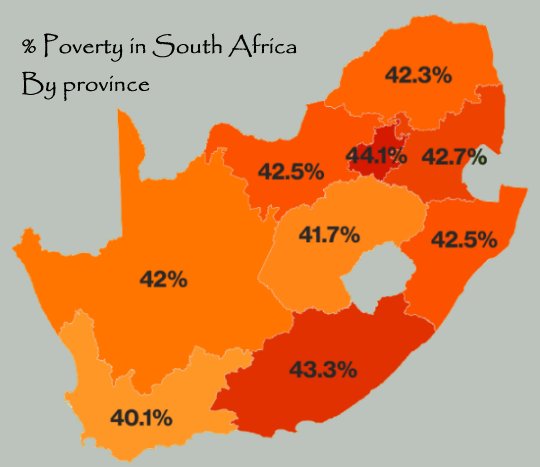|
 Similar inequalities can be seen in the education system when there was one teacher for every 22 white children whereas black children had class sizes averaging 60 students with $696 spent on every white child's education but just $45 per annum for each black child. When apartheid ended, South Africa sought to re-enter to world community by opening its doors to foreign investment and trade however, in doing so, it opened those same doors to foreign labour who took the few jobs available away from native South Africans. This ended with rioting in some areas of the country. It has also been claimed that after 1994 the government was keen to focus on the economy and the empowerment of its black citizens rather than on the basics of health and education yet today as many as two thirds of childhood deaths could be prevented by simple improvements in health care provision. Another factor that has contributed to poverty in South Africa is the prevalence of AIDS with South Africa having the highest number of AIDS infected people than anywhere else on the planet. When the employed or self employed become ill, their source of income is lost with little or nothing remaining to pay for expensive medical and funeral bills. Children in these families are often forced to drop out of school to care for their ill parents or look after younger siblings taking away their one route out of poverty. There are an estimated 1.7 million children in South Africa who have been orphaned through AIDS. Similar inequalities can be seen in the education system when there was one teacher for every 22 white children whereas black children had class sizes averaging 60 students with $696 spent on every white child's education but just $45 per annum for each black child. When apartheid ended, South Africa sought to re-enter to world community by opening its doors to foreign investment and trade however, in doing so, it opened those same doors to foreign labour who took the few jobs available away from native South Africans. This ended with rioting in some areas of the country. It has also been claimed that after 1994 the government was keen to focus on the economy and the empowerment of its black citizens rather than on the basics of health and education yet today as many as two thirds of childhood deaths could be prevented by simple improvements in health care provision. Another factor that has contributed to poverty in South Africa is the prevalence of AIDS with South Africa having the highest number of AIDS infected people than anywhere else on the planet. When the employed or self employed become ill, their source of income is lost with little or nothing remaining to pay for expensive medical and funeral bills. Children in these families are often forced to drop out of school to care for their ill parents or look after younger siblings taking away their one route out of poverty. There are an estimated 1.7 million children in South Africa who have been orphaned through AIDS.  Poverty in South Africa affects all aspects of life. Infant mortality rates are running at 27.5 for every 1000 births (compared to 3.4% in the EU for the same period,) crime is endemic and life expectancy is just 63.86 years. Although interestingly enough South Africa can now boast one of the most clean water systems in the world, due to the lack of sanitation and access in the country's rural communities, the threat of water borne disease is steadily increasing. In fact, in these rural areas, 1.4 million children live in homes that had no safe water supply being forced to rely on unsafe streams for drinking water and 1.5 million children have no access to proper sanitation. Additionally, 1.7 million children in South Africa live in shacks with no proper bedding, cooking or washing facilities. Former Archbishop Desmond Tutu envisaged a 'Rainbow Nation' after apartheid, with all races working together for prosperity for all. However, according to UNICEF in 2020, the child poverty rate for black children remains at 68%, 38% for 'coloured' children and just 11% for white children. Poverty in South Africa affects all aspects of life. Infant mortality rates are running at 27.5 for every 1000 births (compared to 3.4% in the EU for the same period,) crime is endemic and life expectancy is just 63.86 years. Although interestingly enough South Africa can now boast one of the most clean water systems in the world, due to the lack of sanitation and access in the country's rural communities, the threat of water borne disease is steadily increasing. In fact, in these rural areas, 1.4 million children live in homes that had no safe water supply being forced to rely on unsafe streams for drinking water and 1.5 million children have no access to proper sanitation. Additionally, 1.7 million children in South Africa live in shacks with no proper bedding, cooking or washing facilities. Former Archbishop Desmond Tutu envisaged a 'Rainbow Nation' after apartheid, with all races working together for prosperity for all. However, according to UNICEF in 2020, the child poverty rate for black children remains at 68%, 38% for 'coloured' children and just 11% for white children.
 |





